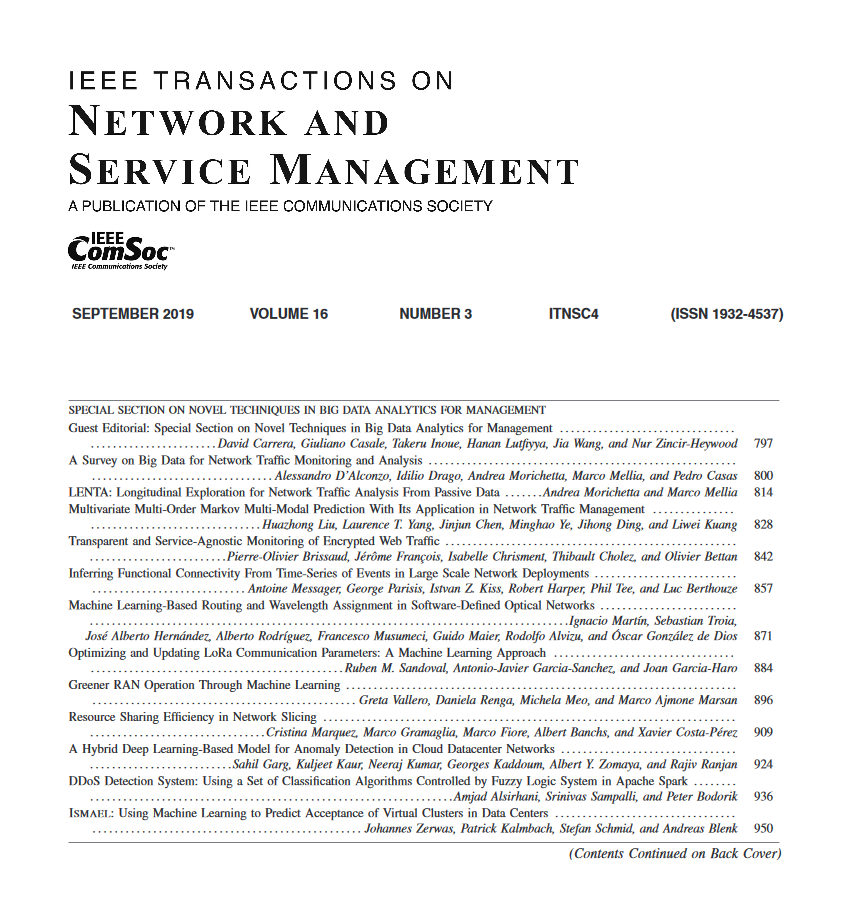FL-ORA: Optimized and Decentralized Resource Allocation Scheme for D2D Communication
IF 5.4
2区 计算机科学
Q1 COMPUTER SCIENCE, INFORMATION SYSTEMS
IEEE Transactions on Network and Service Management
Pub Date : 2025-07-22
DOI:10.1109/TNSM.2025.3591644
引用次数: 0
Abstract
This article presents an optimized and decentralized resource allocation approach aimed at maximizing the system throughput and energy efficiency of device-to-device (D2D) communication. The proposed scheme modifies the meta-heuristic whale optimization algorithm (WOA) by blending the differential evolution (DE) technique in the WOA’s exploration phase to offer intelligence and reduce the computational overburden. The hybrid WOA (DE+WOA) serves as a physical layer access control that efficiently finds the optimal cellular users (CUs) and D2D users (DUs) based on their channel conditions. The proposed access control acts as a restrictive filter, where only optimal CU-DUs can participate in resource allocation tasks. Furthermore, a dataset has been prepared using the optimal CUs-DUs channel conditions from the hybrid WOA to serve as input for the federated learning (FL)-based resource allocation. We utilized statistical tests (e.g., Spearman’s test) to analyze the generated dataset’s non-independent and identically distributed (non-IID) characteristics, thus providing generalization in the AI training. Allowing only the optimal CUs and DUs (from hybrid WOA) in the FL-based resource allocation substantially reduces the computational cost of AI training and improves energy efficiency. In the FL-based resource allocation, we used a sequential convolutional neural network (CNN) trained on the aforementioned dataset to provide proactive resource allocation decisions. Furthermore, we used momentum-based weight aggregation in the FL to reduce the computational burden on the central server. The proposed scheme is assessed by utilizing different standard metrics, such as training accuracy (98.93%), training time, overall system throughput (35.62 Mbps), energy efficiency (96.42 bits/joule), and resource fairness.FL-ORA: D2D通信的优化分散资源分配方案
本文提出了一种优化和分散的资源分配方法,旨在最大化设备到设备(D2D)通信的系统吞吐量和能源效率。该方案对元启发式鲸鱼优化算法(WOA)进行了改进,在WOA的探索阶段融合了差分进化(DE)技术,提高了算法的智能化程度,减少了计算负担。混合WOA (DE+WOA)作为物理层访问控制,根据蜂窝用户(cu)和D2D用户(du)的信道条件有效地找到最优的蜂窝用户(cu)和D2D用户(du)。提出的访问控制作为一个限制性过滤器,只有最优的cu - du才能参与资源分配任务。此外,利用混合WOA中最优的cu - du通道条件准备了一个数据集,作为基于联邦学习(FL)的资源分配的输入。我们利用统计检验(例如Spearman’s test)来分析生成数据集的非独立同分布(non-independent and identically distributed, non-IID)特征,从而为人工智能训练提供泛化。在基于fl的资源分配中,只允许最优的cu和du(来自混合WOA),大大降低了人工智能训练的计算成本,提高了能源效率。在基于深度学习的资源分配中,我们使用在上述数据集上训练的顺序卷积神经网络(CNN)来提供主动的资源分配决策。此外,我们在FL中使用基于动量的权重聚合来减少中央服务器的计算负担。采用训练准确率(98.93%)、训练时间、系统总吞吐量(35.62 Mbps)、能量效率(96.42比特/焦耳)和资源公平性等标准指标对该方案进行了评估。
本文章由计算机程序翻译,如有差异,请以英文原文为准。
求助全文
约1分钟内获得全文
求助全文
来源期刊

IEEE Transactions on Network and Service Management
Computer Science-Computer Networks and Communications
CiteScore
9.30
自引率
15.10%
发文量
325
期刊介绍:
IEEE Transactions on Network and Service Management will publish (online only) peerreviewed archival quality papers that advance the state-of-the-art and practical applications of network and service management. Theoretical research contributions (presenting new concepts and techniques) and applied contributions (reporting on experiences and experiments with actual systems) will be encouraged. These transactions will focus on the key technical issues related to: Management Models, Architectures and Frameworks; Service Provisioning, Reliability and Quality Assurance; Management Functions; Enabling Technologies; Information and Communication Models; Policies; Applications and Case Studies; Emerging Technologies and Standards.
 求助内容:
求助内容: 应助结果提醒方式:
应助结果提醒方式:


